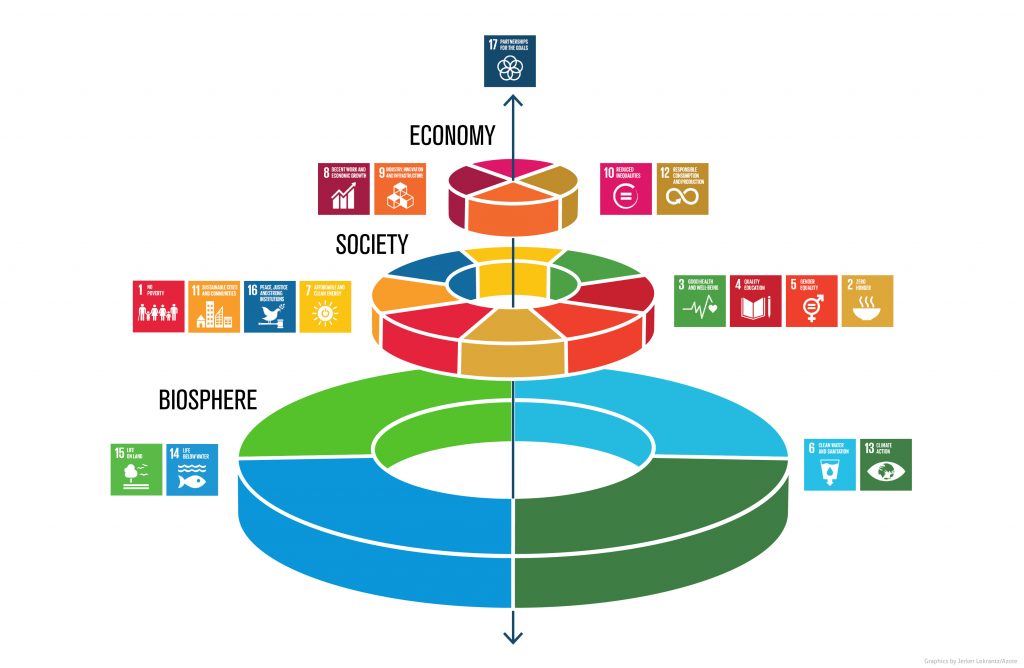The Sustainable Development Goals, also known as SDGs, are the globe’s most exceptional plan to ensure the longevity of life on Earth and consists of 17 sustainable goals in the pursuit to build a better world for people and our planet by 2030. All United Nations member states adopted the sustainable development goals in 2015. The 17 SDGs are a crucial call for action in all developed and developing countries to work together in promoting prosperity while protecting the environment to change our world for the better.
According to the 1987 Brundtland Report, “Sustainable development is the development that meets the needs of the present without compromising the ability of future generations to meet their own needs“. Sustainable development is a process of change that involves the management and operation of resources, the guidance of investments, the course of technological development, and consistent institutional change for future and present needs.
Back in September 2000, global leaders around the world committed to adopting the United Nations Millennium Development Goals or also known as MDGs. The goals were to eradicate extreme poverty and hunger, achieve universal primary education, promote gender equality and empower women, reduce child mortality, improve maternal health, combat HIV/AIDS, malaria and other diseases, ensure environmental sustainability and global partnership for development.
The MDGs were to be achieved by 2015. Although the objectives made significant progress, the progress acquired did not meet the MDGs by 2015. For instance, according to an article published on Guardian, it stated that the rate issue of child mortality has decreased by more than half in the past 25 years, from 90 to 45 deaths per 1,000 live births. However, it did not meet the target of MDG to drop the number of child mortality to two-third.
The SDGs are best demonstrated using the wedding cake developed by Stockholm Resilience Centre science director Carl Folke and others. The wedding cake illustrates that economies and societies are embedded parts of the biosphere. The model provides a new approach and changes the paradigm for development. From social, economic and ecological development were seen as separate parts to transitioning into a world in which the economy serves society where it can evolve within the safe operating of the planet.
The Sustainable Development Goals 2030 recognizes that to end poverty and other ailments. There is an urgent need to include strategies that build economic growth, improve education and health, reduce inequality, and at the same time tackle the global issue of climate change while working to maintain and sustain our oceans and forests. They focus on transforming the world by providing a shared blueprint for peace and prosperity and a plan of action for people and our planet in a global collaborative partnership.
The SDGs value the 5Ps: which are people, planet, prosperity, peace and partnerships. For people, they aim to end poverty and hunger by 2030 and ensure all individuals can achieve their inherent dignity and equality, living in a healthy environment. Aimed at preserving the planet from degradation, and ensuring sustainable production and consumption, they encompass goals for sustaining and managing our natural resources as well as taking action on climate change.
The SDGs aspire to ensure all individuals may have a fulfilling and prosperous life with economic, social and technological growth arising in harmony with nature. They foster peace and aim to free individuals and societies from fear and violence. The spirit is to unite and strengthen solidarity among all 193 member countries around the globe, encouraging humans to work together in a global partnership to implement the 2030 sustainable development agenda.

1. No Poverty
The first goal of SDGs is “No Poverty”, which aims to end poverty in all its forms everywhere around the globe. An article on progress on Goal 1 in 2019 stated that 6 percent of the total population across the world will still be living in extreme poverty in 2030, which means the goal of ending poverty is unlikely to be accomplished by then.
According to a press release published by the World Bank there was a decrease of 10% of individuals in the world living in poverty in 2015, and down from 11% in 2013, which indicates that there is a decline in global poverty, but the progress has slowed. The total number of individuals living on less than $1.90 per day decreased during this season by 68 million to 736 million. With COVID-19 recently impacting the global economy, the World Economic Forum suggests that the Coronavirus will drive 49 million people around the globe into extreme poverty in 2020.

2. Zero Hunger
Zero hunger is the second objective of the SDGs, along with achieving food security, improving nutrition and promoting sustainable agriculture. In 2017, approximately 821 million people or at least 1 in every nine people on the globe were malnourished, with Africa continuing to be the highest continent with individuals suffering from undernourishment. More than 256 million people or one-fifth of Africa’s population experience hunger and undernutrition.
According to the Food and Agriculture Organization of the United Nations, the number of individuals who undergo hunger and undernourishment in 2015 began to increase gradually. In 2018, more than 820 million people around the world were hungry. Consequently, it highlights the immense challenge of attaining the Zero Hunger SDG 2 by 2030.
The novel coronavirus brings another challenge to achieving the zero hunger goal. According to the Global Report on Food Crises, about 55 countries with 135 million population need humanitarian food and nutrition support as the result of the pandemic. Consequently, they have limited capacity to deal with the health and socioeconomic aspects of the shock. In a worst-case scenario, these countries may encounter the experience of saving people from the virus to have them then die from hunger.

3. Good Health and Well-being
Good health and well-being are crucial issues in the Sustainable Development Goals 2030. The goal is to ensure healthy lives and promote well-being among all individuals who have shown significant progress. This goal includes improvement in the health of millions of individuals, increasing life expectancy, reducing maternal and, in particular, child mortality while fighting against leading infectious disease. On the other hand, the progress in addressing primary diseases such as malaria and tuberculosis has slowed down, with essential health services difficult to access by at least half the global population.
The well-being of an individual is determined by the ability to co-exist with others within its environment. An individual’s well-being may come from the ability to obtain nourishment, flourish and keep outside the arm-swing of our fellow homo-sapiens.
There has been a hyper-focus on the concepts of wellbeing and “self-care during the COVID-19 pandemic. As companies shift their work environments to a stay-at-home climate, individuals are focusing more on prioritising their health physically and mentally. Additionally, veganism has been on the rise. In 2018, the UK launched more vegan products than any nation (Mintel Press Office, 2019). A vegan diet, or avoiding animal products has proven to be one of the most significant ways to live a sustainable lifestyle.

4. Quality Education
Education plays a crucial role in society. According to the Brundtland Report, education is one of the critical aspects of population quality. The population issue is not only a matter of the number of people but also how those numbers link to existing resources. With quality education, individuals can better manage those available resources and also deal with the population problem by helping to eliminate mass poverty.
Therefore, having quality education is vital to all countries in the world, and the SDGs aim to foster lasting learning opportunities, ensure inclusive and equitable quality for all individuals by 2030. According to the MDGs Report 2015, Sub-Saharan Africa had the highest progress in primary education of any region, with an increase of 20% in the net enrolment rate from 2000 to 2015. The percentage of reading ability among youth aged between 15 and 24 worldwide has also increased from 83% to 91% between 1990 and 2015.
Regardless of the improvement in education access and enrolment in the past years, there were 262 million children and youth aged 6 to 17 who were not enrolled in school in 2017, and more than half of those kids and adolescents were not attaining minimum proficiency standards in reading and mathematics.

5. Gender Equality
Gender Equality is the fifth objective of the SDGs with focus on achieving gender equality and empowering all women and girls around the world. More girls are now in school and receive an education compared to 15 years ago. Indeed, 41% of females now work outside the agricultural sector, and 90% of countries have more women in congress since 1995. There is also a significant decline in the popularity of female genital mutilation and early marriage, although? The total numbers continue to be high.
Although significant signs are indicating the progression of gender equality, recent data from 106 nations suggest that 18% of ever-partnered women and girls aged between 15 and 49 have suffered from physical and sexual violence from their partners in the last 12 months. Other primary issues related to gender equality such as legal discrimination, unfair social norms and attitudes, decision-making on sexual and reproductive issues and low levels of political participation, also face insufficient progress which can challenge the ability to accomplish the fifth goal in the SDGs.
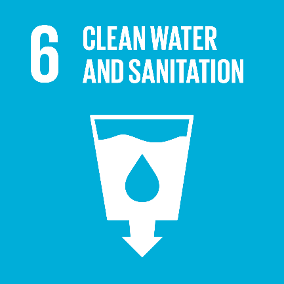
6. Clean Water and Sanitation
Clean Water and Sanitation are still an important issue worldwide. The importance of the problem has prompted innovation to tackle this matter. An example of a clean water solution is Zero Mass Water SOURCE hydro panels. Nevertheless, billions of people still lack safe water, sanitation and handwashing facilities. Data from the United Nations (UN) suggests that 2.1 billion individuals across the globe live without safe drinking water in their homes in 2018.
Although significant progress has been made in creating clean drinking water available to 2.6 billion people in developing countries from 1990 to 2015, yet the SDGs article shows the opposite. Sustainable Development Goals indicates that to have universal access to basic sanitation service by 2030, it necessitates doubling the present annual rate of development. Most nations are questioned with their ability to implement water resources management by 2030.
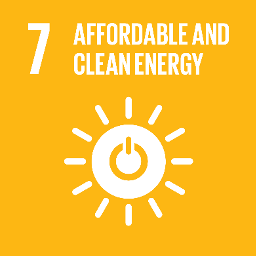
7. Affordable and Clean Energy
Affordable and Clean Energy are the seventh goal in the Sustainable Development Goals. Data shows that access to electricity in the poorest countries has shown improvements, and renewable energy is having gains in the electricity area. However, 800 million individuals continue living with no power and also access to cooking fuels and technologies demand urgent attention.
When it comes to the clean energy sector, China was the most prominent player with an investment of around $100 billion in 2018. The cost of renewable energy is expected to be less than fossil fuels in 2020. Besides, clean energy is an excellent investment nowadays. The index of the NASDAQ Clean Edge Green Energy index increased by 9.91% while oil and gas decreased by 13.25%.
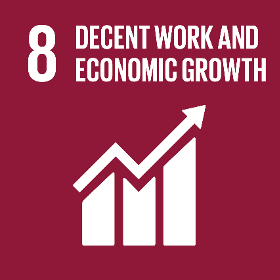
8. Decent Work and Economic Growth
Decent Work and Economic Growth refer to promoting full and productive employment and honest work for all while sustaining economic growth. On a global scale, labour productivity has risen, but the global economy is moving at a slower phase. As a result of the economic downturn back in 2009, labour productivity has been improving around the world, with a consistent annual growth rate since 2010. Labour productivity reached its highest annual growth in 2018, with an increase of 2.1% since 2010.
As a case in point, the novel coronavirus has prompted us to work differently. With the current restriction from the government, businesses and employees are required to find alternative ways to perform the job. Companies such as Google, Apple, Amazon and Nestle are demanding many of their employees to telework. Telecommuting is not only good for business, but it is also a smart and sustainable choice of company. Individuals don’t need to travel to work and spend 10% of their day in traffic, which helps to reduce CO2 emissions from private or mass public transport.
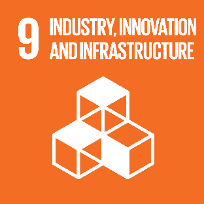
9. Industry, Innovation and Infrastructure
Industry, innovation and infrastructure are included in the Sustainable Development Goal 9. Financial access to economic support has grown in many developing countries, and significant progress also has been achieved in mobile connectivity. Comprehensive and sustainable industrialisation, along with innovation and infrastructure, can support the economic sector that leads to generating employment and income. They play an essential role in announcing and promoting new technologies, enabling international trade and the efficient use of resources.
However, it is still a long way to go to, especially for developing countries as these least developed countries need to accelerate the growth of their manufacturing sector if they are to accomplish the goal by 2030. Moreover, manufacturing development on a global scale has been decreasing at a steady rate, even before the COVID-19 pandemic occurred.
The right to repair initiative demands manufacturers to produce items that can be recycled or repurposed. The right to repair is also a critical issue in the current times, as we have other complex matters that need to be solved, such as climate change, pollution and reducing our need for diminishing resources.
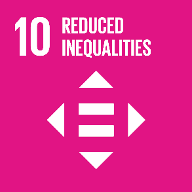
10. Reduced Inequalities
Reduced inequalities within and among countries are the 10th goal in the SDGs. The issue of difference seems to continue although significant progress has been made to tackle different dimensions of inequality such as inequality in opportunity, income and power.
The COVID-19 pandemic has put the poorest and most vulnerable communities in the most challenging situation. In the economic sector, the novel coronavirus pandemic has impacted the growth in global unemployment which has led to reduced workers’ incomes dramatically. It also leaves risks to the progress that has been made on gender equality and women’s rights over the last ten years.
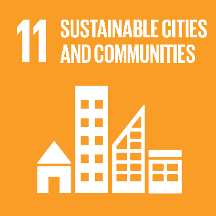
11. Sustainable Cities and Communities
Sustainable cities and communities are achieved by generating countless opportunities in careers and businesses, providing safe and affordable housing, and creating resilient societies and economies. Having sustainable cities involve having investments in public transport, creating green community spaces and refining cities planning and management in comprehensive ways.
However, over 1 billion individuals on a global scale still live in slums, and most majority of cities residents live with poor-quality air and have limited access to public transport and spaces. The sharing economy may provide a new alternative to sustainable cities and communities development goals. It allows individuals and businesses to swap resources on-demand, which can increase efficiency. The latest innovation offers participants to get by without possessing valuable things, such as cars or homes, while providing opportunities for others to obtain value from vacant possessions or talents.
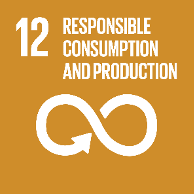
12. Responsible Consumption and Production
Responsible consumption and production are a necessary sustainable action in reducing the harmful effect on the climate change and environment, and also on an individual’s health. Climate change and other environmental influences are significantly affecting developing countries which result in increased poverty and reduced prosperity. Responsible consumption and production mean utilising available resources efficiently, taking consideration of the services related to the ecosystem, which are crucial to making a living, and decreasing the impact of hazardous chemicals.
The material consumption has grown rapidly globally, and the growth of material footprint per capita can be a threat to achieving the SDG 12. Necessary actions are needed to ensure material and environmental resources do not direct to the over-extraction. The activities also should involve policies to increase resource efficiency, decrease waste and ensure sustainability applies to all sectors of the economy.
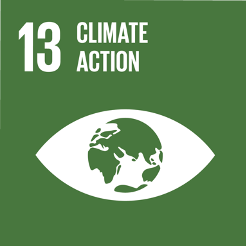
13. Climate Action
Taking urgent action to tackle climate change and its impacts is SDG 13. Climate change is happening much faster than predicted, and countries around the world are experiencing the effects of climate change. For instance, Australia is already facing the impacts of climate change such as heatwave, mass coral bleaching, bushfire and floods.
The economic losses related to climate change cost hundreds of billions of dollars annually. The impact of geophysical disasters on individuals reached 91% between 1998 and 2017 and killed 1.3 million people and also caused 4.4 billion injured. Mobilising US$100 billion yearly by 2020 to developing countries is also part of the action to adapt to climate change and invest in low-carbon development.
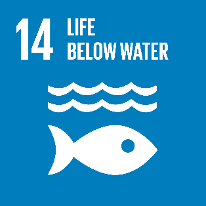
14. Life Below Water
Marine and coastal biodiversity are a critical part of our lives. More than 3 billion people source their incomes from marine and coastal biodiversity sectors. The ocean plays a crucial role in our livelihood as it absorbs around 30% of the carbon dioxide produced by humans. However, the acidification of the ocean has risen to 26% since the beginning of the industrial revolution.
Moreover, major rivers and oceans around the globe account for 80% of trash produced by humans, and urgent action is needed, such as deploying technologies to prevent plastic pollution entering the ocean. South-East Asia and the Indian sub-continent, Western Africa, Central America and the eastern coast of South America are major areas that have been affected.
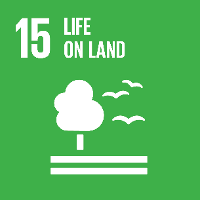
15. Life on Land
Earth is as crucial as the ocean. Individuals depend on these two resources for sustenance and livelihoods. The Sustainable Development Goal 15 is unlikely to be met in 2020, as data shows that biodiversity loss is happening significantly, and the continuance of land degradation is at an alarming rate.
Data from the United Nations shows that 13 million hectares of forests are lost yearly, and this is affecting individuals, mainly affecting poor communities. Although 15% of the land is protected, the significant risk may happen to biodiversity. Approximately, 7,000 types of faunae and florae have been traded illegally. The wildlife trafficking impacts include fuels conflict, feeds corruption, insecurity and erodes biodiversity.
Moreover, when it comes to life on land, individuals build houses and buildings using materials that can impact the earth. For instance, material such as cement is a leading source of CO2 emissions in which it contributes about 8% of all global emissions. Therefore, it is essential to consider not only what’s happening with the forests and biodiversity, but also to look around urban living and the materials used that have a significant impact on the earth.
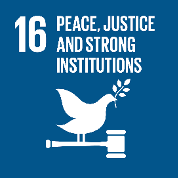
16. Peace, Justice and Strong Institutions
Peace, justice and strong institutions are part of the Sustainable Development Goals. Expansions in ending violence, encouraging the rule of law, consolidating institutions and improving access to justice are imbalance, and they remain disposing of millions of their security, rights and challenge the delivery of public services and broader economic development.
It is crucial to have peaceful, just and inclusive communities to accomplish the SDGs. As an individual, we need to have a safe environment to be free of fear and all types of violence, without acknowledging the ethnicity, faith or sexual orientation. To achieve this goal, we need to work together with governments, civil society and communities. It can be accomplished by having the freedom to express opinions, no discrimination is attached when applying laws and policies to individuals, and institutions should provide accountability to provide essential services to families and communities rightfully.
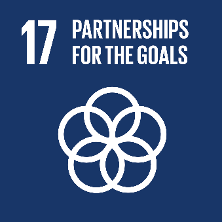
17. Partnerships for the Goals
The Sustainable Development Goals can only be reached by having a strong partnership and cooperation globally. To achieve a successful development plan, it requires collaboration at global, national, regional and local levels. The thriving, sustainable program must be based upon values and principles with a focus on people and our planet.
The SDGs agenda with 17 goals are vital with aims to reduce hunger, end poverty, tackle inequality and climate change. The schedule is a universal plan with calls for actions to all countries around the world to work together and achieve sustainable development goals and making sure no country is left behind. To date, the SDGs is acquiring support from global partnerships, but significant obstacles remain. Therefore, it is vital for everyone – governments, civil society, scientists, academia, communities, families, and the private sector to come and work together and achieve all the 17 Sustainable Development Goals by 2030.
Please visit the THRIVE Project for further information about sustainability, environmental footprint, social inequality and other relevant topics related to sustainable development. THRIVE Project provides technologies and tools guiding society towards providence and prosperity.
Written in collaboration with Tribe member Utari Mijayanti and Billie Shanks.





















